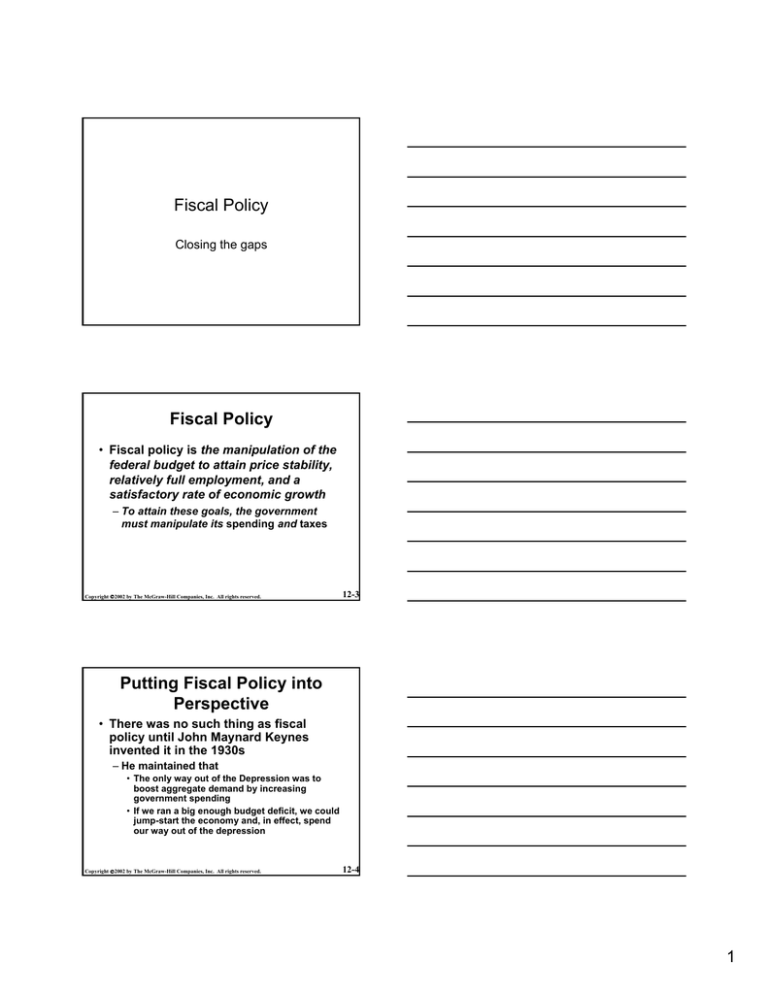
Fiscal Policy
Closing the gaps
Fiscal Policy
• Fiscal policy is the manipulation of the
federal budget to attain price stability,
relatively full employment, and a
satisfactory rate of economic growth
– To attain these goals, the government
must manipulate its spending and taxes
Copyright ©2002 by The McGraw-Hill Companies, Inc. All rights reserved.
12-3
Putting Fiscal Policy into
Perspective
• There was no such thing as fiscal
policy until John Maynard Keynes
invented it in the 1930s
– He maintained that
• The only way out of the Depression was to
boost aggregate demand by increasing
government spending
• If we ran a big enough budget deficit, we could
jump-start the economy and, in effect, spend
our way out of the depression
Copyright ©2002 by The McGraw-Hill Companies, Inc. All rights reserved.
12-4
1
Putting Fiscal Policy into
Perspective
• It’s important that the aggregate
supply of goods and services equals
the aggregate demand for goods and
services at just the level of spending
that will bring about full employment
at stable prices
Copyright ©2002 by The McGraw-Hill Companies, Inc. All rights reserved.
12-5
Putting Fiscal Policy into Perspective
• Equilibrium GDP tells us the level of
spending in the economy
• Full-employment GDP tells us the
level of spending necessary to get
the unemployment rate down)
• Fiscal policy is used to push
equilibrium GDP toward fullemployment GDP
Copyright ©2002 by The McGraw-Hill Companies, Inc. All rights reserved.
12-6
The Deflationary Gap and
the Inflationary Gap
• Equilibrium GDP is the level of
output at which aggregate demand
equals aggregate supply
– Aggregate demand is the sum of all
expenditures for goods and services
(that is, C + I + G + Xn)
– Aggregate supply is the nation’s total
output of final goods and services
– So at equilibrium GDP, everything
produced is sold
12-7
2
The Deflationary Gap and the
Inflationary Gap
• Full-employment GDP is the level of
spending necessary to provide full
employment of our resources
– If our plant and equipment is operating at
between 85 and 90% of capacity, that’s full
employment
12-8
The Deflationary Gap & the Inflationary Gap
The Deflationary Gap
When the full-employment
GDP is greater than the
equilibrium GDP, there is a
deflationary gap. How
much is it?
9
8
Deflationary gap
C + I + G + Xn
7
6
5
4
3
2
1
2
1
$1 trillion
2
3
4
5
6
7
8
9
Full-employment GDP
Equilibrium GDP
GDP (in trillions of dollars)
12-9
Copyright ©2002 by The McGraw-Hill Companies, Inc. All rights reserved.
The Deflationary Gap & the Inflationary Gap
The Inflationary Gap
When equilibrium
GDP is greater
than fullemployment GDP,
there is an
inflationary gap.
How large is it?
2,000
C + I + G + Xn
Inflationary gap
1,500
1,000
500
$200 trillion
500
0
500
1,000
1,500
Full-employment GDP
2,000
Equilibrium GDP
GDP (in trillions of dollars)
Copyright ©2002 by The McGraw-Hill Companies, Inc. All rights reserved.
12-10
3
Cutting
Also increasing
Taxes will
Government
increase C or
Spending
I, causing
cananshift
upward
the
shift
aggregate
in the expenditure
Aggregate expenditure
up and close
andthe
closing
gap. the gap.
Deflationary Gap
C+I+G+Xn
Equilibrium
Full employment
Summary
• Equilibrium GDP is less than fullemployment GDP
– Spending is too low
– Results in a deflationary gap
• Too eliminate the deflationary gap, we raise G
and/or cut taxes
Copyright ©2002 by The McGraw-Hill Companies, Inc. All rights reserved.
12-12
Summary
• Equilibrium GDP is above the fullemployment GDP
– Spending is too high
– Results in an inflationary gap
• Too eliminate the inflationary gap, we cut G
and/or raise taxes
Copyright ©2002 by The McGraw-Hill Companies, Inc. All rights reserved.
12-11
4







